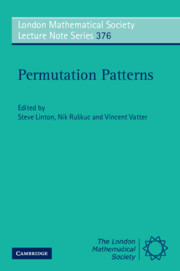Book contents
- Frontmatter
- Contents
- Preface
- Some general results in combinatorial enumeration
- A survey of simple permutations
- Permuting machines and permutation patterns
- On three different notions of monotone subsequences
- A survey on partially ordered patterns
- Generalized permutation patterns – a short survey
- An introduction to structural methods in permutation patterns
- Combinatorial properties of permutation tableaux
- Enumeration schemes for words avoiding permutations
- The lexicographic first occurrence of a I-II-III-pattern
- Enumeration of partitions by rises, levels and descents
- Restricted patience sorting and barred pattern avoidance
- Permutations with k-regular descent patterns
- Packing rates of measures and a conjecture for the packing density of 2413
- On the permutational power of token passing networks
- Problems and conjectures
- References
A survey of simple permutations
Published online by Cambridge University Press: 05 October 2010
- Frontmatter
- Contents
- Preface
- Some general results in combinatorial enumeration
- A survey of simple permutations
- Permuting machines and permutation patterns
- On three different notions of monotone subsequences
- A survey on partially ordered patterns
- Generalized permutation patterns – a short survey
- An introduction to structural methods in permutation patterns
- Combinatorial properties of permutation tableaux
- Enumeration schemes for words avoiding permutations
- The lexicographic first occurrence of a I-II-III-pattern
- Enumeration of partitions by rises, levels and descents
- Restricted patience sorting and barred pattern avoidance
- Permutations with k-regular descent patterns
- Packing rates of measures and a conjecture for the packing density of 2413
- On the permutational power of token passing networks
- Problems and conjectures
- References
Summary
Abstract
We survey the known results about simple permutations. In particular, we present a number of recent enumerative and structural results pertaining to simple permutations, and show how simple permutations play an important role in the study of permutation classes. We demonstrate how classes containing only finitely many simple permutations satisfy a number of special properties relating to enumeration, partial well-order and the property of being finitely based.
Introduction
An interval of a permutation π corresponds to a set of contiguous indices I = [a, b] such that the set of values π(I) = {π(i) : i ∈ I} is also contiguous. Every permutation of length n has intervals of lengths 0, 1 and n. If a permutation π has no other intervals, then π is said to be simple. For example, the permutation π = 28146357 is not simple as witnessed by the non-trivial interval 4635 (= π(4)π(5)π(6)π(7)), while σ = 51742683 is simple.
While intervals of permutations have applications in biomathematics, particularly to genetic algorithms and the matching of gene sequences (see Corteel, Louchard, and Pemantle for extensive references), simple permutations form the “building blocks” of permutation classes and have thus received intensive study in recent years. We will see in Section 3 the various ways in which simplicity plays a role in the study of permutation classes, but we begin this short survey by introducing the substitution decomposition in Subsection 1.1, and thence by reviewing the structural and enumerative results of simple permutations themselves in Section 2.
- Type
- Chapter
- Information
- Permutation Patterns , pp. 41 - 66Publisher: Cambridge University PressPrint publication year: 2010
References
- 8
- Cited by



